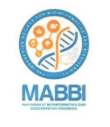RESPONSE OF ATONIC SOLUTION ON GROWTH OF PEA (Pisum Sativum L.) EXPLANTS UNDER DROUGHT STRESS CONDITIONS USING PEG 6000 IN VITRO
Abstract
Peas (Pisum sativum L.) are plants that grow in the highlands which can be consumed as vegetables because they contain high levels of nutrients and protein. In 2018 Indonesia experienced a decrease in the number of pea exports due to decreased supply and continuity caused by environmental factors such as pests and diseases and water shortages. The purpose of this study was to determine the optimum concentration of atonic solution for selecting pea explants, the concentration of PEG that was tolerant to selecting pea explants, and the interaction of atonic solution and PEG 6000 that was tolerant to growth and chlorophyll content of pea explants in vitro. This study was arranged using the basic pattern of a 3x3 factorial design with two factors, namely factor A : Atonic with three concentration levels, namely 0 ml/l (A1), 1 ml/l (A2), 2 ml/l (A3) and factor B : PEG 6000 b/v with three concentration levels, namely 0% (B1), 70% (B2), 80% (B3). Each concentration was repeated 4 times and each replicate consisted of 2 explants of pea seeds in each culture bottle. The results showed the optimum concentration of atonic solution for selecting pea explants against drought stress was 2 ml/l, while the tolerant concentration of PEG 6000 for selecting pea explants was 70%, there was also an interaction between atonic 2 ml/l and PEG 6000 70% in increasing growth and chlorophyll content of pea explants in vitro.
Full Text:
PDFDOI: https://doi.org/10.47007/ijobb.v7i2.196
Refbacks
- There are currently no refbacks.
| Indonesian Journal of Biotechnology and Biodiversity Published by: Publishing Department of Esa Unggul University Arjuna Utara No 9 Street Kebon Jeruk Jakarta - 11510 Indonesia | |








.png)

